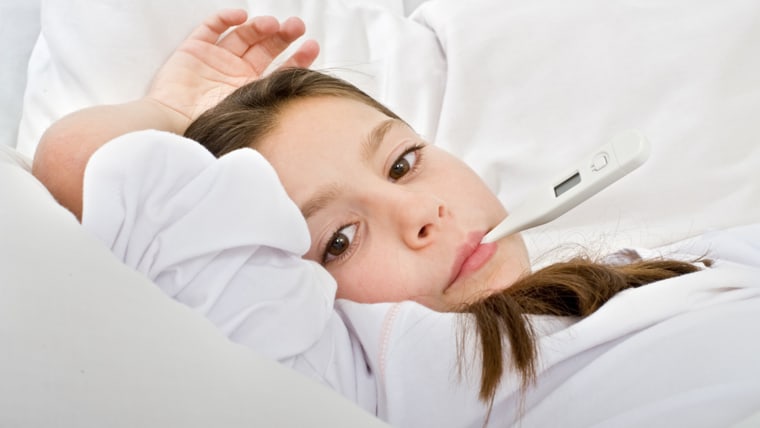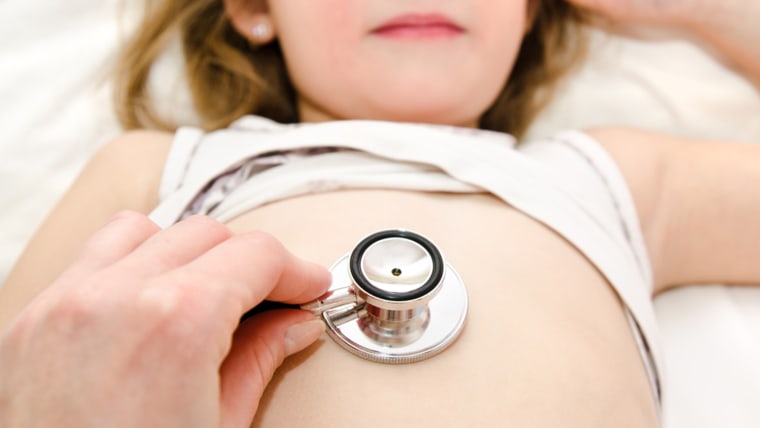When a fever strikes or your child is in pain, it can be easy to feel helpless and overwhelmed. So many health issues can pop up as your little one grows up — some are completely routine; others will require a trip to the doctor or ER.

Here are 10 common health symptoms in kids and expert advice about each:
1. High fever
Fever is an indication that something is going on in the body, but for most children, the elevated temperature itself is not dangerous, said Dr. Mary Brown, a pediatrician at Floating Hospital for Children at Tufts Medical Center in Boston.
The exception is newborns, because they are still at risk for serious infections related to the birth, such as group B strep, she noted. Plus, their immune system is still very immature.
If your child is 3 months old or younger and their temperature is 100.4° F or higher when taken rectally, take them to the emergency room, said NBC medical contributor Dr. Natalie Azar.
For older kids, it’s less about the temperature than the accompanying symptoms, experts note.
“How does the child look? Are they acting well? If they’re acting fine and doing their normal activities, and they happen to have a fever, you don’t even need to treat the fever,” Brown said.
“It gets more worrisome if they’re not acting themselves.”
If a child is very sleepy, unresponsive, complaining of ear pain or something specific, have them checked out, Brown advised.
Doctors also get concerned if a fever lasts longer than five days because it's a sign the body may be having a hard time fighting the illness off by itself, said Dr. Melissa Seifried, a pediatrician at Cleveland Clinic Children’s. Any fever over 105° F also warrants medical attention, she noted.
Related: Pediatricians release updated guidelines for children's medical screening
2. Leg pain
It’s not uncommon for kids to complain that their legs are a little achy, typically at night time, Brown said. Many times, you can chalk it up to “growing pains,” or sensations associated with growth spurts, which resolve themselves, she added.
But watch out if a child is limping, refuses to bear weight on a leg, has swelling or prolonged leg pain, Seifried advised. Have a doctor evaluate the problem when those symptoms are present.
Sometimes, kids who get viral infections can have transient synovitis — a temporary inflammation of the hip — afterwards. They’ll suddenly start limping and seem to have joint pain, either hip or knee pain, and doctors will watch them to make sure the situation resolves over the next week or so, Brown said.
Other things to keep in mind with leg pain include sports injuries in older kids and problems with hip joints in children who are obese.
3. Headaches
This feels like a grown up problem, but many children suffer from headaches, too, even migraines.
Common reasons include improper glasses, stress in school and dehydration, Seifried said. She recommended keeping a symptom diary before you decide to see a doctor: Is it throbbing pain, or sharp stabbing pain? Is it located on one side of the head, or all over?
Migraines, which can run in the family, are usually more severe and may involve light or sound sensitivity, and vomiting.
If you want to home medicate, in general it’s fine to give an over the counter child pain medication, Seifried said. Have them drink plenty of fluids and take a nap in a dark room.
See a doctor any time your child has a headache and reports blurry vision, seems to have neck stiffness or complains of any weakness or numbness in his body, she advised.
Related: Are child safety caps enough to keep kids out?
4. Stiff neck
A stiff neck that comes and goes (but isn’t persistent), or is caused by sleeping funny, usually isn’t a big deal, Seifried noted. She recommended using ibuprofen for pain relief and watching the symptoms.
A stiff neck is concerning, however, when doctors suspect an infection of the brain and spinal cord.
A child with this symptom who also has a fever, is a little sluggish and not quite acting like themselves should go to the emergency room for further evaluation and possibly a spinal tap, which lets doctors look at cells inside the spinal fluid, Seifried said.
5. Vomiting
Vomiting itself is not dangerous, but the worry is that kids who aren’t able to keep anything down will get dehydrated, Brown said.
She encourages parents to call if they’re concerned, but that doesn’t necessarily mean the child needs to come in and be seen by a doctor.
“The problem is we can’t make the vomiting stop,” she noted. “There’s not a lot we can do about it.”
To avoid dehydration, the key is to give your child small sips of fluids — teaspoons-full every 20 minutes or so, Brown advised. If he can keep it down, gradually increase that amount or decrease the interval between sips.

6. Diarrhea
Stomach bugs happen all the time. The problem here, as with vomiting, is the potential for dehydration.
Fluids are more important than food and they don’t have to be plain water, Seifried said. When your child has diarrhea, he’s also losing electrolytes so she recommended younger children drink Pedialyte or a similar solution to help restore what the body is losing. Older children may find Gatorade more palatable, she noted.
You can also try giving your little one popsicles, Jell-O or ice chips to rehydrate them. Watch for signs of dehydration, such as a child not urinating for hours or a baby that's not making tears or whose soft spot on his head is noticeably sunken. That requires a trip to the ER and possible IV fluids.
Seifried typically doesn’t recommend anti-diarrhea medications for children.
“If you have food poisoning, your body is trying to get rid of those toxins and bacteria, so you don’t necessarily want to slow down the diarrhea,” she said.
Related: Kids and caffeine may be a dangerous combination
7. Cuts and scrapes
Skinned knees seem an inevitable part of childhood. For most ouch-causing incidents, put direct pressure on the cut for about 5-10 minutes and once the bleeding stops, gently wash it with soap and water, Seifried said. You can put antibiotic ointment on it and then cover with a bandage.
Head to the emergency room if the bleeding persists, because it may be a sign the wound is too deep to close on its own, she noted. Any cut that’s gaping open may need stitches or skin glue to close.
See your doctor if your child has a wound that’s starting to develop pus, puffy yellow drainage or has a yellow crusting to it, plus it’s red and tender to the touch after a couple of days. It may be the sign of a secondary bacterial infection.

8. Rashes
The itching, the spots, the redness! Rashes can ruin any kid’s day. Common home remedies include aloe vera, Benadryl, and hydrocortisone cream.
If a rash is associated with other symptoms like fever or a swelling of the joints, have a doctor check it out, Seifried advised. A rash accompanied by a sore throat may be scarlet fever.
“If it’s rapidly spreading and it’s raised up, we could be concerned about hives,” Seifried said. “Hives by itself is not an emergency, but if they’re having any coughing or difficulty breathing, we worry that the allergic response is going to compromise their airway and they definitely need to be seen for that in the ER.”
9. Excessive thirst
If your child is simply chugging water with no other symptoms, there’s usually no concern, Seifried noted.
But excessive thirst accompanied by frequent visits to the restroom, abdominal pain or change in weight needs to be checked out because it could be a sign of type 1 diabetes.
“That is something we see parents worry about a lot. Most of the time it’s nothing, but a pediatrician can easily do a urine test to make sure,” Seifried said.
10. Difficulty reading
Approaching this just right depends of the age of the child.
Really young kids who’ve had frequent ear infections or problems with speech can have those issues impact their reading ability later on, Seifried said. Youngsters can also benefit from a vision and hearing test to screen for any troubles.
“My advice to parents of young children would be to read to them often and expose them to books,” she added. “Take them to the local library. We recommend reading to children 6 months of age and up as part of your daily nighttime routine.”
For older kids, talk to their teacher to see if she has any insight and see if the school can do a screening for learning problems. If there’s a reading disability, the child may need extra support.
For all kids, consider the environment: New stress at home or a family history of learning problems may provide some clues, Seifried said.
Limiting children’s time with gadgets could also help. The American Academy of Pediatrics recommends no screen time for kids under 2, and no more than two hours of screen time for older children.